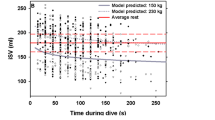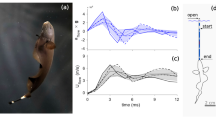Abstract
MARINE snakes and turtles are probably the deepest diving reptiles. Sea snakes dive to maximum depths of at least 40 m with air in the lung1. Pressure at this depth potentially produces the formation of N2 bubbles in the blood and other tissues during decompression, yet sea snakes ascend to the surface rapidly and do not seem to be affected by caisson disease. Here I show that N2 concentrations in the blood and tissues may remain much lower than that in the pulmonary blood because of a large venous shunt and a low but significant permeability of the skin to dissolved gas.
This is a preview of subscription content, access via your institution
Access options
Subscribe to this journal
Receive 51 print issues and online access
$199.00 per year
only $3.90 per issue
Buy this article
- Purchase on Springer Link
- Instant access to full article PDF
Prices may be subject to local taxes which are calculated during checkout
Similar content being viewed by others
References
Heatwole, H., and Minton, S. A., in Biology of Sea Snakes (edit by Dunson, W. A.) (in the press).
Van Slyke, D. D., Dillon, R. T., and Margaria, R., J. biol. Chem., 105, 571–596 (1934).
Graham, J. B., Respir. Physiol. (in the press).
Belkin, D. A., Respir. Physiol., 4, 1–14 (1968).
Krogh, A., J. Physiol. Lond., 52, 391–408 (1919).
Harvey, E. N., McElroy, W. D., Whiteley, A. H., Warren, G. H., and Pease, D. C., J. cell comp. Physiol., 24, 117–132 (1944).
Paulev, P., J. appl. Physiol., 20, 1028–1031 (1965).
Graham, J. B., Gee, J. H., and Robison, F. S., Comp. Biochem. Physiol. (in the press).
Berkson, H., Comp. Biochem. Physiol., 18, 101–119 (1966).
White, F. N., Fedn. Proc. 29, 1149–1153 (1970).
Landis, A. T., Undersea Tech., 6, 21 (1965).
Berkson, H., Comp. Biochem. Physiol., 21, 507–524 (1967).
Kooyman, G. L., S.E.B. Symposium, 26, 295–311 (1972).
Author information
Authors and Affiliations
Rights and permissions
About this article
Cite this article
SEYMOUR, R. How sea snakes may avoid the bends. Nature 250, 489–490 (1974). https://doi.org/10.1038/250489a0
Received:
Revised:
Issue Date:
DOI: https://doi.org/10.1038/250489a0
This article is cited by
-
Diving of the sea snakePelamis platurus in the Gulf of Panam�
Marine Biology (1986)
-
Distribution of ventilation and perfusion in the sea snake,Pelamis platurus
Journal of Comparative Physiology ? B (1981)
-
Ventilation and gas exchange in the Carpet Python,Morelia spilotes variegata
Journal of Comparative Physiology ? B (1977)
Comments
By submitting a comment you agree to abide by our Terms and Community Guidelines. If you find something abusive or that does not comply with our terms or guidelines please flag it as inappropriate.



